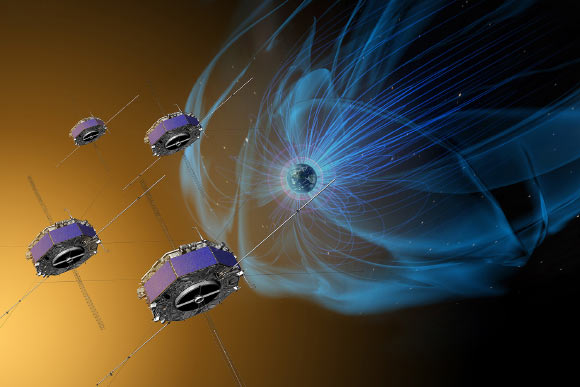Interplanetary shocks are a type of collisionless shock — events where particles transfer energy through electromagnetic fields instead of directly bouncing into one another. These shocks are a phenomenon found throughout the Universe, including in supernovae, black holes and distant stars. NASA’s Magnetospheric Multiscale (MMS) mission has obtained unprecedented high-time resolution multipoint particle and field measurements of an interplanetary shock event.

The four MMS spacecraft — shown here in an artist’s concept — have made more than 4,000 trips through the boundaries of Earth’s magnetic field. Image credit: NASA / Goddard / Conceptual Image Lab.
Interplanetary shocks start at the Sun, which continually releases streams of charged particles called the solar wind.
The solar wind typically comes in two types: slow and fast. When a fast stream of solar wind overtakes a slower stream, it creates a shock wave, just like a boat moving through a river creates a wave. The wave then spreads out across the Solar System.
On January 8, 2018, MMS was in just the right spot to see one interplanetary shock as it rolled by.
The spacecraft was able to measure the shock thanks to its unprecedentedly fast and high-resolution instruments.
One of these instruments, the Fast Plasma Investigation (FPI), can measure ions and electrons around the spacecraft at up to 6 times per second.
Since the speeding shock waves can pass the spacecraft in just half a second, this high-speed sampling is essential to catching the shock.
Looking at the FPI data from January 8, Dr. Ian Cohen from the Johns Hopkins University Applied Physics Laboratory and colleagues noticed a clump of ions from the solar wind.
Shortly after, they saw a second clump of ions, created by ions already in the area that had bounced off the shock as it passed by.
Analyzing this second population, the scientists found evidence to support a theory of energy transfer first posed in the 1980s.
“MMS consists of four identical spacecraft, which fly in a tight formation that allows for the 3D mapping of space,” they explained.
“Since the four MMS spacecraft were separated by only 12 miles (19 km) at the time of the shock, we could also see small-scale irregular patterns in the shock.”
The findings are published in the Journal of Geophysical Research: Space Physics.
_____
Ian J. Cohen et al. High-Resolution Measurements of the Cross-Shock Potential, Ion Reflection, and Electron Heating at an Interplanetary Shock by MMS. Journal of Geophysical Research: Space Physics, published online June 18, 2019; doi: 10.1029/2018JA026197







